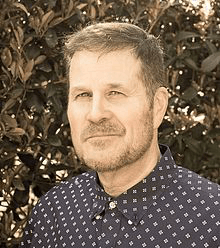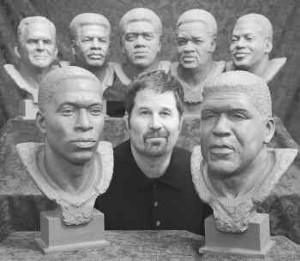Aggie Pro Football Hall Of Fame Sculptor To Bring Talent Back To Texas A&M
Scott Myers has cast bronze sculptures of National Football League players for the Pro Football Hall of Fame since 2003.

Scott Myers, a graduate of Texas A&M University, has cast bronze sculptures of National Football League players for the Pro Football Hall of Fame since 2003, but now he is bringing his talent back to campus by creating a bronze relief sculpture of a highly regarded professor who passed away in 2005.
Myers, an animal science and veterinary school graduate and Fort Worth native, is working with animal science department head Russell Cross to create a bronze relief sculpture — a relief sculpture gives the impression that the sculpted material has been raised from the background — of the late Howard Hesby, which will be displayed in the Howard Hesby Student Atrium located in the Kleberg Animal and Food Sciences Center.
“Dr. Hesby was my freshmen adviser and the first person I showed my art to in college. He was an important person in my life and always supported me,” Myers said. “When Dr. Hesby would take students on tours across Texas and the nation, he would hand the tour site hosts one of my drawings as a token of appreciation.”
Myers first proposed the idea about the sculpture to Cross.
“He described it with such passion, we were sold,” Cross said. “He indicated that he would make Hesby come alive.”
Until the relief is finished, which could take up to six months, a sketch by Myers has been prepared to hang in the atrium.
Growing up, Myers enjoyed his time in the rodeo arena, participating in calf and team roping events. His love for horses and western life was also evident on paper. Myers remembers himself as an artist in his classes. That creative side, combined with his appreciation and understanding of agriculture, first produced drawings of western scenes.
“I sold my first art in 9th grade. A drawing was due every week in art class, and my teacher began taking my art to the teachers’ lounge, selling it and bringing me back the money,” Myers explained.
Word of his work spread locally, and bull and bronc riders in the Professional Rodeo Cowboy Association (PRCA) began requesting him to draw them. The budding artist was able to support himself in high school by drawing portraits of the champion riders, as well as selling art to his teachers and at the Fort Worth Stock Show and Rodeo and Mesquite Championship Rodeo.
“As I got older, I became more interested in livestock and western art, which is a perfect blend for me,” he said. “I am able to take my two interests and put them on a canvas or paper. In college, I was studying animal science, and I took what I saw in class and made it into art.”
At Texas A&M, Myers would draw an original piece and sell it with the agreement that he could make prints. He would use money from the original sale to fund copies of the drawing and then sell prints. This enterprise enabled him to pay his way through both his degrees.
Myers returned to the Fort Worth area in 1984 to begin his career as a veterinarian.
He also continued developing his interest in western art and honing his craft. In 2002, he sold the clinic he had opened in 1984 to make more time for his art, though he continues to work at the clinic.
“The things I am involved in during the day, I paint and draw at night,” he added.
Crediting his anatomy class in veterinary school with helping him to accurately sculpt, draw and paint has helped Myers create beautiful artwork.
“I was doing a large sculpture of a horse and was under the abdomen when I realized, I have seen this a million times. I was sculpting based on what I see when I am under a horse checking for hernias,” Myers said. “When I am describing conditions to clients at the clinic, I always draw a picture for them.”
In junior high, Myers completed a three-dimensional piece of art. This sparked an interest in sculpting that was shelved for years because he didn’t have the finances to pursue it. However, in 1990, he decided to start creating bronze sculptures, so he took evening classes for sculpting and casting.
“I have always searched for and found people who I believe are the best in their art and asked them to mentor me,” he said. “In 1992, I met Blair Buswell, who at the time was sculpting for the Pro Football Hall of Fame, and he agreed to help me develop my sculpting.”
That relationship not only developed his art ability, but created a much bigger stage for his work.

Myers began sculpting bronze heads for the Pro Football Hall of Fame inductees in 2003.
“When drawing people, the muscles and bones are the same and named the same as animals, so I am still using my animal anatomy education,” he said, adding that he feels this is one reason his work has been so readily accepted.
Myers spends two weeks sculpting the inductee’s cast before he ever meets with the individual.
“It is tough, because you have 25 pounds of wet clay sitting on a metal armature, and the slightest slide or bump can alter the appearance greatly,” he said.
Chris Hanburger, a 2011 inductee to the Pro Football Hall of Fame and former linebacker for the Washington Redskins from 1965 to 1978, worked with Myers to complete his bronze cast for the induction ceremony.
“He is a true professional, there is no question about it,” Hanburger said.
The way a player looks from his rookie year versus the mature look at the end of his career can be very different, Myers said, and he encourages inductees to choose a more current look so that when standing by the cast, it is a more true representation.
Working with Myers, Hanburger chose a photograph from mid-career and requested modifications to make his hair shorter in the cast, since that is how it is currently cut.
“He was working on my sculpture and called me to ask if I had ever broke my nose. I had in fact broken it twice, and he could tell from the pictures and my bone structure,” Hanburger said.
Hanburger said his measurements were taken at the 2011 Super Bowl in Arlington, and the measurements, along with pictures, were given to Myers. When he arrived at Myer’s studio, most of the bust was already finished.
When a player comes to the studio, Myers said the individual will sit for four to six hours the first day, go home and rest, and return the next day for another six hours of sitting.
“Sculpting for the Pro Football Hall of Fame has been above and beyond what I imagined. Every year around April 1, things get in high gear as everything with the sculptures has to be done by August for ESPN,” Myers added. “It is a special feeling to see your work on television and Monday Night Football.”
Myers’ work has also been recognized by Sports Illustrated. The magazine named Myers’ bronze bust of Bruce Matthews, who played 19 seasons for the Oilers/Titans franchise, as “Best of the Hall of Fame” in August 2011. Matthews was inducted into the Pro Football Hall of Fame in 2007. Matthews has even more personal connections to Texas A&M: his son, Kevin, played football for the Aggies until 2009, and he currently plays in the NFL for the Tennessee Titans. Additionally, Matthews’ son Jake is sophomore offensive lineman for the Aggies.
Visit Scott Myers’ website for more information on Myers. Story first published in Volume 10, Issue 2 of AgriLeader magazine and written by Lindsay Garrett, a senior agricultural communication and journalism major.
